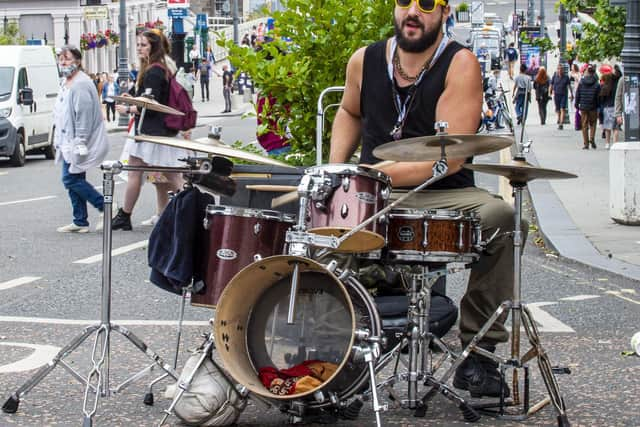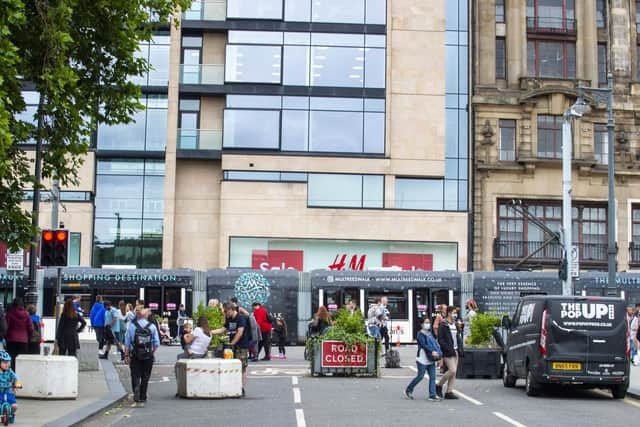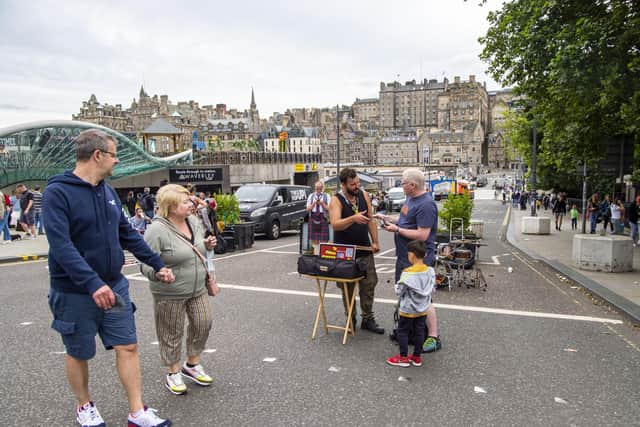Edinburgh's famous Waverley Bridge paves the way for a more welcoming city centre
Let us know what you think and join the conversation at the bottom of this article.
Instead of diesel engines and car horns, music and chatter now provide the soundtrack to this famous stretch of road.
The temporarily pedestrianised space was home to a mobile vaccination centre in the shape of a Lothian Buses double-decker, and has been adopted as a venue by street performers during the festival. Social media users have shared videos of crowds gathering around musicians performing by the junction next to the iconic Scott Monument.


Advertisement
Hide AdAdvertisement
Hide AdThe bridge, connecting Market Street and Cockburn Street to Princes Street, was closed in June 2020 under emergency decision making powers which came into effect in response to the coronavirus pandemic.
The closure is part of the controversial ‘Spaces for People’ initiative, which was developed at the height of the pandemic to allow more space to socially distance and to make the city friendlier to pedestrians and cyclists.
As restrictions were being eased over the summer, Edinburgh City Council carried out a public consultation to find out whether people wanted these measures to be continued.


The subsequent report found: “City centre measures, including Princes Street East End, Victoria Street, George IV Bridge and Waverley Bridge had relatively high levels of support for retention in both market research and public consultation.” It was agreed that the closure would be retained on an experimental basis, allowing for amendments at subsequent council meetings.
Speaking about the effects of the closure on his business, Mark Donald, the owner of The Milkman cafe at the bottom of Cockburn street, said: “The closure hasn’t affected us too much to be honest, with Cockburn Street now pedestrianised and the top half of the Royal Mile closed to vehicles from 10:30am each day we don't see a great deal of traffic on the street throughout the day, yet it is still very busy.”
This pedestrianisation is part of a long term plan to transform many parts of the city centre into less vehicle-centric spaces. The City Mobility Plan and ‘Edinburgh City Centre Transformation’ plan aim to pedestrianise more areas in the years to come and commit to making the closure of Waverly Bridge to traffic permanent.


The other five areas highlighted for change in the Edinburgh City Centre Transformation plan are Princes Street, Victoria Street, Morrison Street, Tollcross Junction, and Teviot Place.
The incremental evolution planned for Waverley bridge specifically includes: removal of unnecessary street clutter, paving a continuous surface for ease of access, introduction of street furniture along the outer edge of the bridge, and construction of a new square and viewpoint
Advertisement
Hide AdAdvertisement
Hide AdCouncillor Lesley Macinnes, the city council’s Transport and Environment Convener, said: “The closure of Waverley Bridge to motor traffic has been one of the most visible changes under Spaces for People. As restrictions began to ease, it offered a safe environment for people to meet, spend time and visit local businesses and, as our major consultation and marketing research demonstrated, this change has been welcomed by many.
“We’re now planning to retain the measure longer term, on an experimental basis, to see how works as we return to more of a sense of normality. We’ve already seen musicians performing and people gathering, as well as using the route to walk, cycle and wheel safely over recent months, and we want to see that continue and to animate the space for everyone’s enjoyment.”
Councillor Karen Doran, Transport and Environment Vice Convener, said: “Any longer term changes on Waverley Bridge reflect our commitment through the City Mobility Plan to increase pedestrian space and to create a people-friendly city centre. Under our Edinburgh City Transformation strategy too, the transformation of Waverley Bridge, removing traffic and creating a welcoming environment for the public, would result in a new world-class space and gateway to the city.”
A message from the Editor:
Thank you for reading this article. We're more reliant on your support than ever as the shift in consumer habits brought about by coronavirus impacts our advertisers.
If you haven't already, please consider supporting our trusted, fact-checked journalism by taking out a digital subscription.
Comments
Want to join the conversation? Please or to comment on this article.